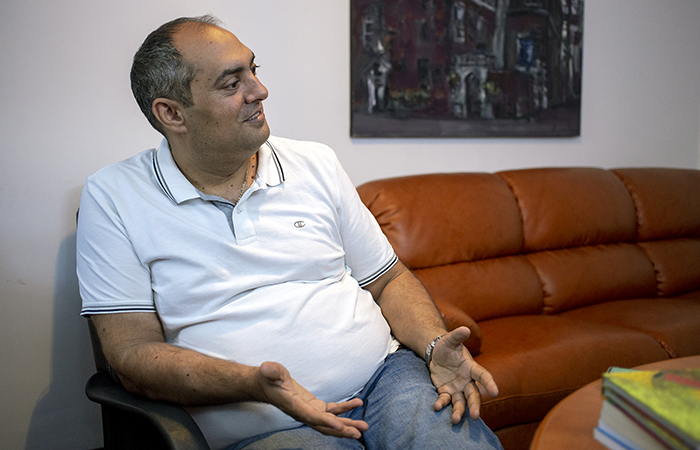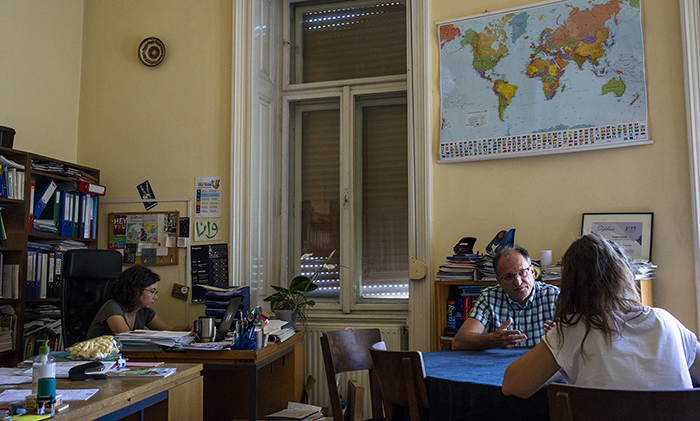News
“We no longer want to be second-class citizens. We do not beg for rights, but demand them”: the Roma struggle in Romania
30 years after the fall of Ceauşescu, the group fights against structural racism, presses for opportunities · “New generations of Roma have reasons to be optimistic,” it is argued by associations
We are in Bucharest, at the headquarters of Agentia Impreuna, one of the most active associations for the rights of the Roma population in Romania. In the last few years, pressure from groups such as Agentia Impreuna has made the history books of Romania talk about the slavery suffered by the Roma, the deportations during Nazism, or their life during Communism. “We create tools to answer questions —those of our children and of the rest of society. The fight against prejudice is complex, that’s why we have to give answers,” says Gelu Duminică, who is the executive director of the organization.
Agentia Impreunta works in a local way, with close reality. “We have few resources, and we prefer to allocate them to projects that we know will have tangible results.” They work in building affordable housing, lighting of houses, searching for employment or training. “We do this by listening to the community, knowing what their priorities are,” says Duminică. They also work to change the Roma’s perception of themselves: “The problem is when you start believing what others say about you. For us, the most important actors of change are the individual and the community, and let us not forget: the well-being and development of the Roma community are necessary for the well-being and development of the rest of the society.”
Out of 6 to 8 million Roma in Europe, an estimated 2 million live in Romania: this is where they have the largest presence. In this country, now commemorating the 30th anniversary of the fall of Nicolae Ceauşescu and of the communist dictatorship, not only the Roma, but the whole of Romanian society, still have a number of challenges ahead in terms of integration.
It is true that conditions undergone by the Roma have improved in the last three decades, but many challenges lay ahead. According to the European Union’s second survey on minorities and discrimination against the Roma population, conducted by the European Agency for Fundamental Rights (with data from 2016), Romania and Slovakia are the only two EU countries where the schooling of Roma children has stagnated in the last decade. The prevalence of discrimination against the Roma in the search for jobs, as well as their little knowledge about support and equality organisations or campaigns and legislation for their rights, continue to be a reality, both in Romania and in the rest of Europe.
In such a context, Gelu Duminică has been working for 20 years to make his people overcome all these obstacles. Agentia Impreuna wants to take a different approach to integration: “When we talk about the needs of the Roma, we often only talk about their primary needs. This is racism. A different approach must be taken. For many things you don’t need money, you need to understand what the needs are, and keep your eyes open. We are not only Roma, we have other identities too.” Duminică works to change that paradigm, and does so from an innovative approach: he wants to show with socio-economic indicators the importance of the contribution of the Roma to society, and he portrays the groups as a necessary economic agent. Secondly, he takes stereotypes and turns them around: “Would you rather want my child to insult you because he or she feels discriminated against, or do you prefer to invest so that this does not happen?”.
 Agentia Impreuna's Gelu Duminică. / Photo: Bru Aguiló.
Agentia Impreuna's Gelu Duminică. / Photo: Bru Aguiló.He acknowledges that the population is racist, despite being politically correct: “Statistics are there, and so are stereotypes. These people need arguments to stop being racist, and we are willing to provide them. We suffered fierce slavery, communism, racism. We have always been victims, and we cannot erase that, but the last three decades we have come a long way, and new generations of Roma have reasons to be optimistic.” Duminică looks to the future. However, what was the situation of the Roma during one of the most important periods of modern Romania, the communist period?
The Roma under communism
To understand the situation of the Roma in Romania today, one has to look at the communist dictatorship (1947-89). Unlike other countries in the orbit —such as Hungary, where some children were separated from their families and many Roma villages were destroyed, or Czechoslovakia, where Roma women were even sterilized—, in Romania there was no systematic state policy against the Roma of such intensity, explains Viorel Achim in his book The Romani in Romanian History. The regime, most of the time, ignored them. In fact, it was not until 1989 that they were identified as an ethnic group. This meant that until then they had no representation anywhere as a national group, and no institution took care of their needs as a collective.
During the early years of communism, the Roma joined the labour market with some success, and some gained positions of responsibility. However, this promotion [...] occurred not so much under the aegis of the policy of promoting national minorities […] but rather in the conditions of the Communist regime’s social policy, which aimed at fostering the development of the poor classes and at destroying the old social structure that was unwilling to accept the new order,” as a “simple and certain means of securing loyal followers,” Achim writes. Those who lived in the countryside were given land. Women also joined the labour market.
While it is true that nationalizations, the transformation of cities, collectivization and the process of industrialization had positive effects on the Roma, most communities also underwent an assimilation process. By the 1960s they were forced to settle down in fixed settlements built by the Communist Party under a state plan. The measure did not have the desired effects. In 1977, there were still 65,000 nomadic Roma in Romania. Sedentarization caused the Roma to disseminate throughout the country, which contributed to the destruction of traditional communities.
It was at the end of the 1970s when the Communist Party began to look at them and the first integration programs were devised, of which little information is available. Achim writes that “the authorities made land available to them and assisted them in the procurement of building materials for houses. Many Gypsies were given jobs. Gypsies lacking official identification were registered at the civil status office, measures were taken to legalise marriages between Gypsies, to send Gypsy children to school.”
Many Roma, however, never managed to find their place in the system, as “in general [they] regarded employment in a regular job as an imposition”, the historian writes. The urban planning process did not help either: during the 1970s and 1980s the regime demolished small towns to make cities bigger. Standardized and uniform blocks of flats were built. Evictions and migration processes were forced, and public services were reduced in rural areas. This had a negative effect on the Romanian population, and especially on the Roma, who saw their settlements destroyed. Achim, however, sees a positive side: “Many” Roma got to be “housed in blocks of flats with a level of comfort higher than that of their former dwellings.” He recognizes, however, negative consequences, as the demolition of Roma neighbourhoods “meant the end” for the respective Roma communities.
One of the measures with the most macabre legacy (12,000 dead women and more than 100,000 abandoned children) of the regime was the adoption, in 1966, of Decree 770/1966, which prohibited abortion and contraceptives. From then until the fall of the dictator, women had to undergo monthly gynaecological check-ups to monitor menstruation and pregnancy. Corina Dobos, a researcher at the University of Bucharest and an expert on Ceauşescu’s pro-natalist politics, points out to Nationalia that this measure did not affect the Roma community much, although she admits that there is not much documentation on the group under the communist regime.
The fall of communism
“When the regime fell in 1989, and the economy went to the dogs [although in fact, the economy had already collapsed during the 1980s, when Ceauşescu had to pay the debts of the loans that the International Monetary Fund had granted Romania], the Roma were the first to lose jobs, and their condition deteriorated,” says Calin Rus, director of the Intercultural Institute of Timişoara, founded in the 1990s. Social programs were lost, and the Roma community was badly hit. If, during communism, health services were universal, with the fall of the regime hospitals could only used by those who had jobs. This contributed to the pauperization of the Roma people. “Many Roma women had to leave their children abandoned in orphanage hospitals because they could not support them. Stereotypes were also generated at the time,” Rus says. Changes in legislation concerning the right to land —plots were given to people from agrarian cooperatives, but the Roma received nothing— created inequalities in rural areas.
Resignifying what it means to be a Roma
In addition to socio-economic ones, another challenge faced by the Roma is also important: the resignification of what it means to be a Roma. “We are perceived as a vulnerable group, not as an ethnic minority with rights. What are we teaching our children? Why should they be proud to be Roma? They see poverty in the media, but not all Roma are poor. Some Roma are doctors and lawyers. We want to teach our children that ethnicity is not a vulnerability, that they should be proud. We Roma have to assert our cultural rights and demand from the authorities what belongs to us. We live in a society in which offering us rights means losing votes at elections. Enough is enough: we want to stop being second-class citizens. We are not begging for rights, we are demanding them”, says Duminică.
For him, to have drinking water is a right, not charity; to have access to an inclusive, quality education is a right, not charity: “We have to fight to keep alive our culture and identity. And for this reason, the state not only has to take a human rights approach, but it must protect us as the minority that we are.”
At the Intercultural Institute, Calin Rus is a proponent of a policy of empathy: “Prejudices should not be fought denying the reality of some facts, but trying to understand the reasons why this reality exists.” His association, in addition to working with the Roma, also works with city councils: “A lot of resistance in some institutions still exists, as does the general idea among officials that they know best what suits the communities and their people. Sometimes they don’t understand them and blame them for their situation. Cases of structural racism also exist,” Rus explains. “We carry out community development strategies with an integral and participative approach. It is essential to incorporate the people’s point of view, so we are incorporating participatory digital tools.” It is easier for them to work at a micro level so that changes are more visible. One of the projects with the best results has been that of cultural mediators, which has made it possible to fight against school absenteeism and has generated confidence in the educational system. In fact, the programme has been implemented as a national education policy.
 Calin Rus at the Intercultural Institute of Timișoara. / Photo: Bru Aguiló.
Calin Rus at the Intercultural Institute of Timișoara. / Photo: Bru Aguiló.Dulture stakeholders are also trying to make Roma traditions and culture known. This 2019, the main focus of the Histories and Film Festival in Râşnov has been freedom, and one of the debate panels has been integrated only by Roma. “We usually talk about ‘freedom’ in a general way, focused on the feelings of 1989, when the dictatorship fell. Now we should be talking about ‘freedoms’, because there are many kinds of them. When we speak of ‘freedom’, we also speak of economy, sentimental freedom or freedom to maintain traditions. In this country, there are still people who don’t have these freedoms,” says Mihai Brezeanu, referring to the Roma. Brezeanu is the festival’s communications director.
Despite all the programmes that are being carried out, discrimination against the Roma is still worrying, and there is a lot of racism in public discourse. Anti-Roma racism has been on the rise in Europe in recent years. “Unprovoked assaults, fatal police beatings, and attacks on whole villages, in which houses are burned and people are lynched, are known to have occurred with frightening commonality. Although the Roma have always been a socially and economically marginalized population in Eastern Europe, now more than ever Roma communities and neighbourhoods are often found lacking in electricity and clean water,” Florinda Lucero and Jill Collum write in this article.
The Roma in the media
The media are essential in the fight against discrimination. Ionut Codreanu is one of the coordinators of Active Watch, an organisation established in 1994 that monitors hate speech in the media, provides training for journalists and conducts research: “Since the fall of the regime until now there have been changes in the perception of the Roma in the media. 30 years ago you could read in newspapers calls to lynch Roma communities. That’s unthinkable now. As we approached 2000, with EU membership, everything was softened. The state began to monitor hate crimes, and inclusion policies were put in place for the EU to see that we were doing well. Political attitudes changed, and the media became more professional and loosened up,” he says. But Codreanu admits that a lot of work remains to be done: “Some newspapers still stigmatize [the Roma], some television programmes laugh at them, and a dangerous new narrative that is spreading.”
Such a new narrative has to do with the image that other European countries have of Romania. “Since we joined the EU, we have detected a new narrative about the Roma in the media: they are blamed for the country’s image. It is said that the Roma embarrass us as a country, and some are asking to switch the official denomination [in Romanian] from ‘roma’ to ‘ţigan’, so that they are not longer associated to the country. The ethnicity of offenders is still mentioned. That doesn’t help to fight stereotypes.”
Gelu Duminică admits that he uses the media as much as he can: “Talking to the media has allowed me to create a network of contacts that I use to gain support and get the message across. I invest a lot of time in interviews, because I see the media as allies to change things.”
 With support from the
With support from the Ministry of Labour,
Social Affairs and Families
Government of Catalonia
